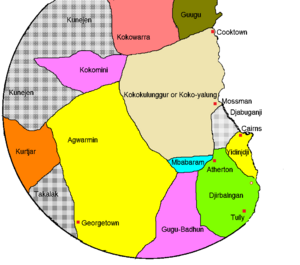Mbabaram people facts for kids
| Mbabaɽam | |
|---|---|
| Regions with significant populations | |
| Languages | |
| Mbabaram (historically), English (Australian English, Australian Aboriginal English) | |
| Religion | |
| Australian Aboriginal religion and mythology, Christianity | |
| Related ethnic groups | |
| Other Dyirbal peoples, Walangama, Agwamin, Mbara, other Aboriginal Australians |
The Mbabaram or Mbabaɽam people are an Indigenous Australian group. They traditionally lived in the rainforests of the Atherton Tableland in Queensland, Australia. They are sometimes called the Barbaram people.
Contents
Mbabaram Language
For a long time, the Mbabaram language was a puzzle. It seemed very different from other Indigenous Australian languages. People thought it might be a "language isolate," meaning it wasn't related to any other known language. This was because many Mbabaram words were very short, often just one syllable. This was unusual for Australian Aboriginal languages.
However, a linguist named Robert M. W. Dixon solved this mystery. He learned that Mbabaram words often dropped the first part of a word that was present in nearby languages. For example, the word for 'west' in Mbabaram is wo. This came from an older word guwa. The word for 'dog' in Mbabaram is simply dog. This word didn't come from English. It came from an older word like gudaga, which is used in the Yidiny and Dyirbal languages.
Once this rule was understood, the Mbabaram language no longer seemed strange. It was actually a regular Paman language, just like many other Aboriginal languages in Australia.
Mbabaram Country

The Mbabaram people's traditional land is on the Atherton Tableland. Their land was bordered by other groups. To the north, it was near the Kuku Yalanji people, close to Dimbulah and almost to Mareeba. To the east, it was near the Dyirbal people. To the south, it reached down to Irvinebank and the Warungu lands. Their territory stretched from west of Almaden across Lappa and east to Atherton.
Some researchers believe that the Mbabaram people might have moved from the rainforest into drier, scrubland areas a long time ago. By the time studies were done in the 20th century, many descendants lived in rocky, granite areas.
Mbabaram History
In 1880, people discovered tin in the Mbabaram area. This led to more non-Indigenous people moving into their lands. Before this, it's thought that about 500 Mbabaram people lived there.
By the mid-1960s, mining and the clearing of the rainforest had a big impact. Sadly, the Mbabaram population had become very small.
The Barrinean Idea
In the past, some researchers, like Norman Tindale and Joseph Birdsell, had an idea about different groups of people settling Australia. They thought that some groups, like the Mbabaram and other rainforest tribes, were remnants of the first people to arrive in Australia. They called these groups "Barrineans."
This idea was partly based on how the Mbabaram language seemed so different. However, later linguistic studies by Robert M. W. Dixon showed that the Mbabaram language was actually connected to other Australian languages. This meant that the language did not support the "Barrinean" idea.
Today, most scientists do not support these older ideas about different "waves" of people settling Australia. Modern research shows a more complex and unified history for Indigenous Australians.
Notable Mbabaram People
Two elders, Albert Bennett and Alick Chalk, helped researchers learn about the Mbabaram language. In the 1970s, they shared about 300 words and basic grammar rules with linguists like Robert Dixon. Their help was very important for understanding the language's structure and its links to other languages.
Some Mbabaram Words
- dog – meaning 'dog' (not related to the English word)
- gungdg – meaning 'kookaburra'
- yú – meaning 'fish'

